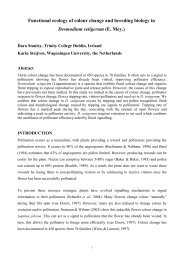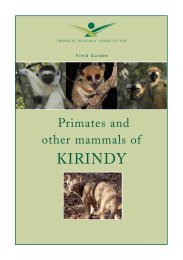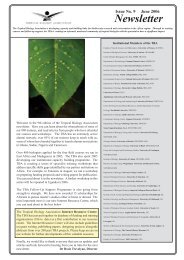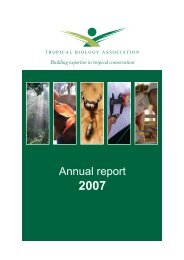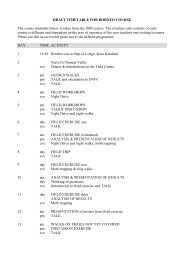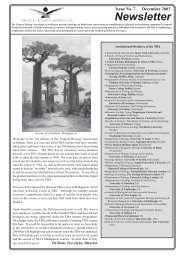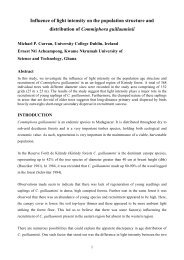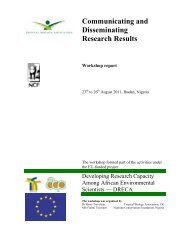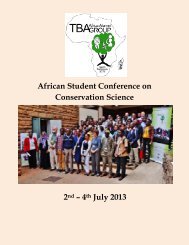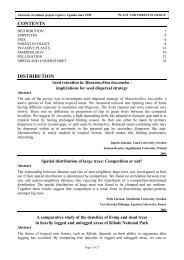Download TAAG Book of Abstracts - Tropical Biology Association
Download TAAG Book of Abstracts - Tropical Biology Association
Download TAAG Book of Abstracts - Tropical Biology Association
You also want an ePaper? Increase the reach of your titles
YUMPU automatically turns print PDFs into web optimized ePapers that Google loves.
Managing biological resources: Anthropogenic<br />
pressure on plant community structure in Mt. Marsabit<br />
forest, Kenya<br />
* 1 Eunice W. Githae and 2 David W. Odee<br />
1 School <strong>of</strong> Natural Resource Management, Narok<br />
University College, P. O. Box 861-20500, Narok, Kenya<br />
2 Drylands Research Programme, Kenya Forestry<br />
Research Institute (KEFRI), P. O. Box 20412-00200,<br />
Nairobi, Kenya<br />
*E-mail for correspondence: egithaeh@gmail.com<br />
Abstract<br />
Mt. Marsabit forest is the main water catchment in<br />
Marsabit district and the main source <strong>of</strong> foliage for<br />
livestock to the surrounding communities. Currently, the<br />
forest is under anthropogenic pressure leading to<br />
continued habitat degradation and loss <strong>of</strong> biomass and<br />
diversity on the mountain. This study was therefore<br />
conducted to identify the impacts <strong>of</strong> human activities on<br />
vegetation structure and composition in order to<br />
develop strategies for its conservation and proper<br />
management. Fifty two species <strong>of</strong> trees and shrubs,<br />
twelve species <strong>of</strong> herbs and six species <strong>of</strong> climbers and<br />
lianas were recorded belonging to 35 families and 64<br />
genera. Rubiaceae was the richest family observed with<br />
nine species. Rinorea convallaroides (Bak.f.)Eyles ssp.<br />
Marsabitensis, Grey-Wilson (Violaceae), an endemic<br />
species, and Drypetesgerrardii Hutch. (Euphorbiaceae)<br />
had more than a third <strong>of</strong> the total importance value.<br />
Eight vegetation associations were identified based on<br />
the dominant species, namely; Croton dichogamous,<br />
Strychnos henningsii, Rinorea convallaroides,<br />
Erythroxylum emerginatum, Cassipourea malosana,<br />
Teclea simplisifolia, Olea europaea and D. gerrardii.<br />
Most <strong>of</strong> the vegetation types were highly disturbed by<br />
grazing, honey harvesting and firewood collection.<br />
There was a high proportion <strong>of</strong> open canopies<br />
predominated by light-dependent species e.g. Ocimum,<br />
Bauhinia and Asparagus species, indicating severity <strong>of</strong><br />
the disturbance. The density <strong>of</strong> tree communities with<br />
30 cm diameter at breast height was very low, an<br />
indication <strong>of</strong> climax vegetation elimination. Women and<br />
children played a major role in vegetation changes<br />
through collection <strong>of</strong> wood and non-wood forest<br />
products as a source <strong>of</strong> income. The success and future<br />
management and conservation strategy <strong>of</strong> the forest<br />
will largely depend on how to reduce the human<br />
pressure. This can be done by development <strong>of</strong><br />
community agr<strong>of</strong>orestry projects in order to provide<br />
both wood and non-wood forest products to the<br />
communities as well as silvo-pastoralism for high quality<br />
fodder for their livestock.<br />
Diversity and pathogenicity <strong>of</strong> ophiostomatoid fungi<br />
found on native trees in the Cape Floristic Region<br />
Tendai Musvuugwa<br />
Stellenbosch University, South Africa<br />
Email for correspondence:tmusvuugwa@gmail.com<br />
Abstract<br />
Almost nothing is known about fungi associated with<br />
native trees in South Africa, yet many plant species are<br />
evidently threatened by native and exotic fungal<br />
species. Ophiostomatoid group <strong>of</strong> fungi comprise<br />
serious plant and human pathogens. It is therefore<br />
important to investigate the ecology and diversity <strong>of</strong><br />
ophiostomatoid fungi associated with native trees in the<br />
Cape Floristic Region (CFR) <strong>of</strong> South Africa. Bark and<br />
wood samples were collected from diseased native<br />
trees <strong>of</strong> the CFR. Ophiostomatoid fungi were isolated<br />
from collected samples and sequenced for<br />
identification. Some <strong>of</strong> the fungi were tested for their<br />
pathogenicity on native trees. Potential vectors<br />
(ambrosia and bark beetles and mites) <strong>of</strong> these fungi<br />
were collected and identified. Feeding studies were<br />
conducted for some <strong>of</strong> these mites on the fungi they<br />
vector and fungi that they do not normally vector to<br />
give an indication <strong>of</strong> the ease <strong>of</strong> host jumping. Eighteen<br />
ophiostomatoid fungal species have been collected and<br />
ten are new species. Some <strong>of</strong> them were pathogenic on<br />
various native tree species such as<br />
Rapaneamelanophloeos, Oleacapensis and<br />
Curtisiadentata. Numerous beetles and mites were<br />
identified as vectors <strong>of</strong> ophiostomatoid fungi. Some <strong>of</strong><br />
these mite species feed on ophiostomatoid fungi and<br />
showed a high level <strong>of</strong> specificity towards the fungi they<br />
normally vector.<br />
Keywords: Ophiostomatoid, pathogenic, vectors<br />
Keywords: Biodiversity, Conservation, Community<br />
structure, Disturbance, Mt. Marsabit forest,<br />
<strong>TAAG</strong> First African Student’s Conference, Nairobi. 2-4 July, 2013 39




